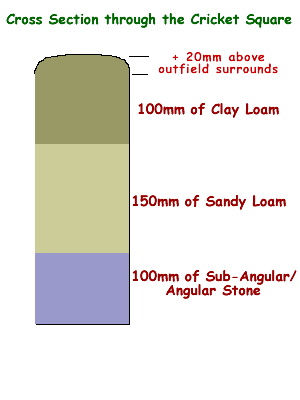1. The area of the whole works, including the extent of the surrounds, where a contractor can have a compound etc. will need to be clarified somewhere in the documentation.
2. It is advisable to include some method or level of quality control throughout the period of the construction, although the requirements will vary depending upon circumstances. If the square is being constructed by a contractor then relatively high levels of quality control are usually written into the specification. If on the other hand the square is being constructed by groundstaff employed within an educational establishment, then start and finish times may only be required. Whilst this latter scenario may seem suitable to an administrator, it isn't really acceptable to the turf professional who will want to know, at the very least, the depths and quantities, as well as the exact types of materials actually used throughout the whole period of the construction. This will help in writing a maintenance programme for the square as well as providing background information if a problem ensues later in the squares life.
3. The Contractor should provide a statement describing how the works are to be carried out (e.g. a 'Method Statement'), including details of machinery, staffing (with relevant qualifications) and a timetable for monitoring purposes.
4. The Contractor should provide at least 24 hours notice before starting a number of tasks, such as the following(This should provide for an inspection or quality control check to take place if required):
- The start date of the works;
- The initial marking out of the work area
- The finished setting out of the levelling pegs,
- The consolidation of the base of the excavated square;
- The laying of the sub-base stone;
- The laying of the sandy loam,
- The laying of the clay loam,
- Initial surface preparation and seeding works,
- Certain maintenance operations of the square and outfield, e.g. fertiliser / pesticide application.
5. All materials must comply with the relevant material specifications. Samples of all materials should be provided to the Customer prior to acceptance by the Contractor from his supplier. The samples will act as a comparison for future deliveries.
6. Any materials which do not meet the required material specification may be classed as being unsuitable and may have to be removed from the site at the Contractors own expense. This will help to encourage the Contractor to implement their own quality control on materials.
7. To comply with relevant Highway Acts etc. and to ensure residents are not unduly inconvenienced, it is essential that the Contractor takes measures to prevent dirt or foreign matter from being deposited upon any highway, footpath or access way. Where this does occur it is up to the Contractor to remove the material and clean the area, usually at their own expense.
8. Any damage whatsoever caused by the Contractor will also have to be rectified at their own expense. This would probably be covered by their insurance anyway.
9. Liaison with organisations, such as the highways authority or water board, that impact on the works should be undertaken by the Contractor.
10. During the progress of works the Contractor would usually have to carry out the following:
- Ensure services, e.g. sewers, cables etc., are protected and should allow the relevant authority appropriate access for inspection, repair, renewal or removal of any part of their service;
- Ensure that any services affected by the works are substituted with a temporary service for the period - or part of - the works.
11. All proposed excavations and gradings should be appropriately marked out.
12. If weather or ground conditions would contribute to unacceptable damage occurring, then work should stop until it is suitable to recommence.
13. The Contractor should clear and remove from site any rubbish and unwanted materials on a regular basis and should leave the whole of the works and the adjoining land in a clean and orderly condition upon completion.
14. The finished works shall achieve the stated standards. A catch all sentence may include "to the complete satisfaction of the Customer", however, this would need to be reasonable and this can be notoriously difficult to define from a legal perspective. Workmanship should consistently be to a high standard and in accordance with the Institute of Groundsmanship Professional Code of Conduct, or similar.
15. Throughout the whole period of the construction the area that is being constructed and used for machinery operation should be adequately fenced off and maintained throughout, with suitable signage erected to ensure the safety of the general public is maintained. Following adequate grass establishment the fencing shall be removed after agreement from the Customer.
16. Site Plans and Drawings
- Reference will need to be made to the number of Plans and Drawings that relate to the construction specification.
- For example, a general location map may be needed, especially if contractors are being expected to price for the work; a site plan for the positioning of the square; a cross-profile of the constructed square, and existing site levels to provide guidance on possible cut and fill requirements and for blending in of the square to the surrounds.
A typical cross-profile drawing of a cricket square might be as the following:

